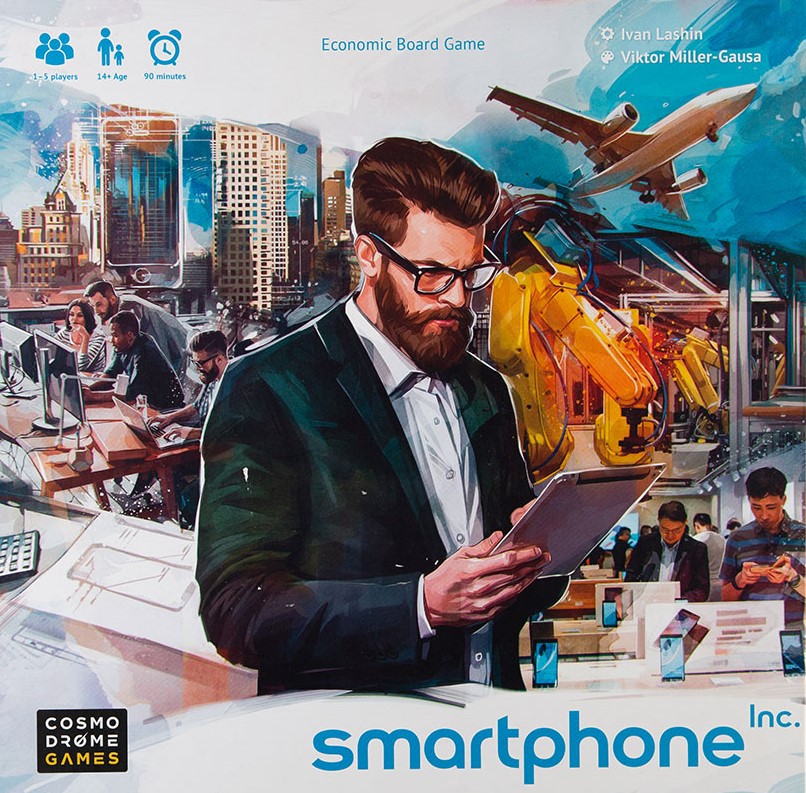From the Publisher:
Come back to the time when smartphones were only beginning to conquer the world: it’s your destiny to become the new CEO of one of the most promising smartphone design corporations.
This is your chance to be a top disrupter in the digital economy. If you’re going to make your company the biggest in the world, you’re going to need all your business savvy as you set prices for your products, streamline your production, develop new technologies, manufacture goods, and handle logistics and sales.
Choose your strategy well and don’t forget to keep your plans secret if you want to win this race. Other companies want the same as you: to create the largest (and richest) smartphone company of all time.
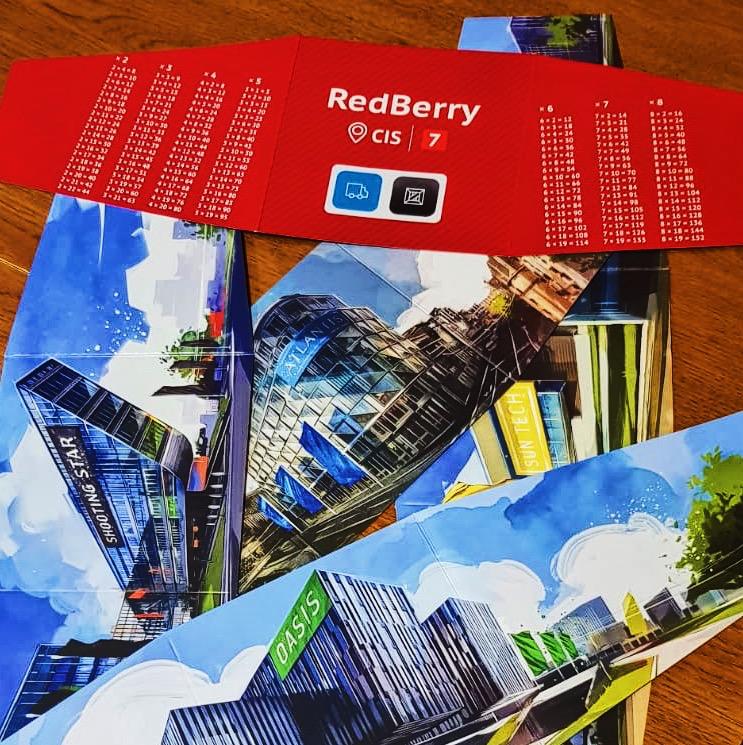
Year Published: 2018
Number of Players: 1-5
Playing Time: 60-90 minutes
Intro
In Smartphone, you can play as any of the TelCo’s in the 90’s with the goal of global domination in the cellular world. Smartphone is an economic game where you take the role of a company working to take over global regions in sales and patents. The game is played out over 5 rounds, with each round having 8 different phases.
Game Setup & Rules Overview
Setup for the game is straightforward – each player starts by picking a color and taking the progress markers, office markers, goods markers and organizer for that color. Each player gets 2 pads, and a privacy screen that matches their color. Each screen will show the starting region for each player. Place an office marker in the office space for that region and place a goods marker on the scorecard that matches your color. Take the starting improvement tile that matches your color. Each player than places a goods maker on the Price Block board on the ‘5’ space.
A little about the pads mentioned above. Each player will be using these two boards, aka pads, to determine their resources and actions throughout the numerous phases of the game. The pads are identical between all players, and are double sided. Each side has 4 icons, each representing the different actions or resources you can get during the appropriate phase. Additionally, you’ll notice that each board has an icon on the top corners (one light, one dark) – you’ll want to make sure each player has one of each. Usage of the cards are done in Phase 1, where you’ll be overlaying them one over the other, with the restriction that you have to cover at least 1 space of the other card.
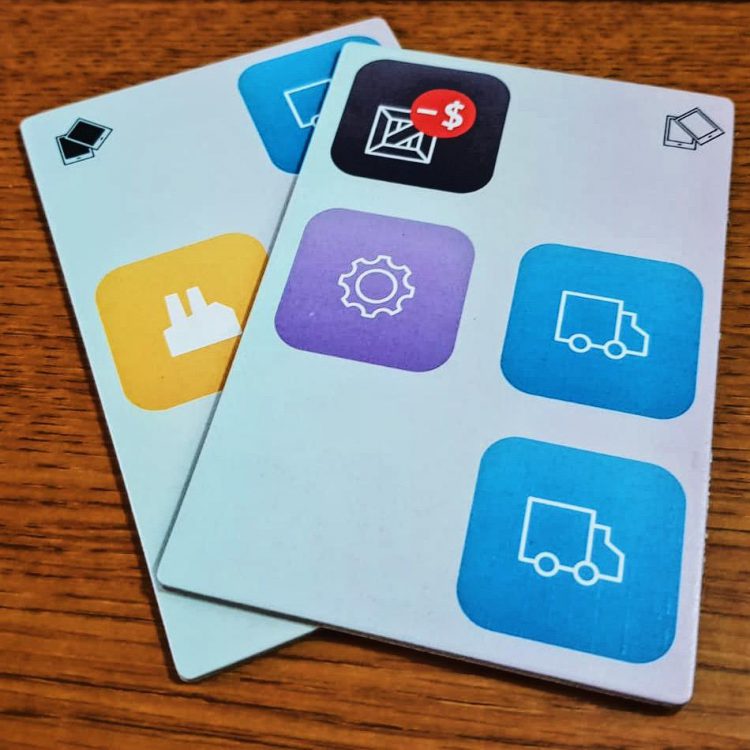
Setup of the board depends on the number of players that are going to play. The game support from 1-4 players (for solo game play, the game has an AI called Steve who will play. The AI can be used with any number of players up to a 5th player). Depending on the number of players in the game, you’ll be covering up some of the regions with markets that match their market size (Small, Medium, Large size regions and matching size retailers). The game has a number of different ‘retailer’ tiles that you can randomly select for placement in there, as long as they match the size of the market.
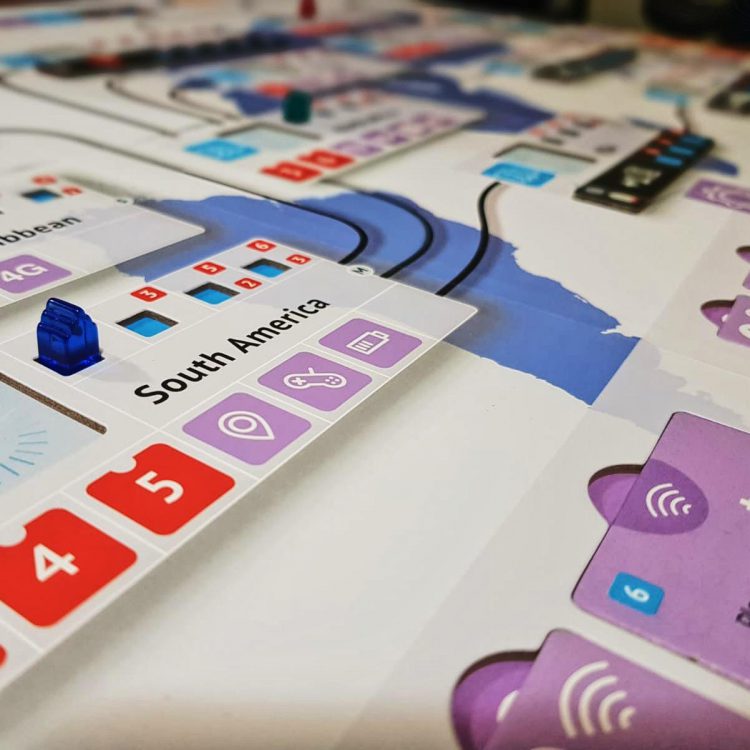
Place the round marker in the first space on the board and the space marker on the first space of the board. Shuffle improvement tiles and place 5 down on the board face-up. Shuffle and place the goods tokens near the improvement tiles.
Place the 6 patent tiles down on the board and place the technology tiles that match the patent tiles next to them. Place the score tracker to the side of the board and place your color marker on the tracker board in the circle that has your color and place a matching color marker on the pricing area in the 5th section. Note that these should be placed in the same order that they are placed on the scoring tile.
Game Mechanics
Game-play for Smartphone Inc consists of 8 phases played over 5 rounds. Each phase must be completed before moving to the next phase in the game. The phases are as follows:
Phase 1 is the planning phase, where each player will take their pads and, while behind their screen, will place the pads over each other to cover cells displayed on the pad. The pads must cover between 1-4 icons of the pad that will be placed underneath. The pads will stay hidden behind the screen until all players have finished this phase. Once all players are done with this, they will move the screen to show their boards. The icons left visible on the board are used in the future phases and help determine what goods/actions you will have during each phase.
Phase 2 is where the prices are set for the goods that are going to be sold. At the start of each round, prices are set back to 5, then based on the number of price icons visible from phase 1, each player will adjust their pricing up or down. Note: This is important, not just for the cost value, but in phase 4, this is also used to determine the order that each player will take their turn.
Phase 3 is where you would produce goods for the market and place them in your organizer. There are two ways to produce good from your pads, by either having an active symbol visible, and also by the number of covered cells on your pad. Additionally, with improvements (Phase 4), research (Phase 5), and retailers (Phase 7), you can also increase this.
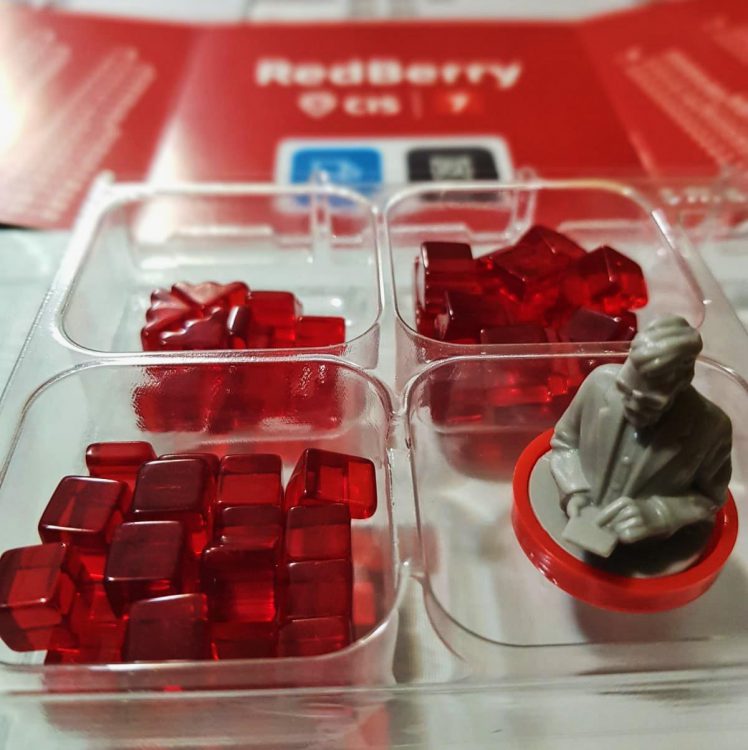
Phase 4 is where you would work on improving your production. Remember where in Phase 2 I mentioned how the order is selected based on the prices set? This is where they kick in. The person with the lowest price will go first, followed by the next lowest and on until all players have their turn. On this phase, each player can take 1 of 2 actions, based on whether they left the improvement icon visible on their pads in phase 1. If it is visible, they can take an improvement of their choice from that block. If they did not have it visible, they can take a goods token instead and use it in the next round.
Phase 5 is where we can research technologies to boost sales or provide bonuses. Still using the priority rule from Phase 4, each player can spend their tech icons to research new technology. Each player can choose not to spend all their tokens but note that they will disappear at the end of the players turn. Each Technology card shows the number of tokens needed for that tech to be unlocked and made available. Once the Technology has been fully researched, the player can take their tokens off the card, and place their office token in there, showing that they have mastered it. More importantly, the first player to research the technology can claim the patent for that technology for some extra victory points. Here’s the kicker – while the card shows a cost, until a patent is taken, the actual cost is +1. Once a patent is claimed, the cost for other players is -1.
Phase 6 is where we start looking at logistics and the growth into different regions across the map. Looking at their pads, each player determines how many tokens they will receive. Following the priority from phase 4, you can then expand to additional regions that are linked to the regions that you have an office in. If you do not place all of your tokens on your turn, you will lose them at the end so you want to make sure you plan and place them in the regions that will benefit you the most (or block your opponent if you think they are going to try and move into that region). Also note that certain regions can only hold so many offices, so it is possible to be locked out of a region.
Phase 7 is where the good stuff happens – selling goods. To sell goods, 3 different conditions must be met. Those are: 1.) have an office in the region 2.) there are not retailers in the region (more on this shortly) and 3.) there are buyers in the region. Each region has different types of buyers, so not everything you made in Phase 3 and technology in Phase 4 might be sold in every region. As you can see, the decision you made in Phase 1 has carried over across the different phases and will impact what you can and will sell in this region, including the prices that you set in Phase 3
Phase 8 is the scoring phase, where you add up your victory points and move the tracker on the score board forward. The screens have the tables on them to help determine how many points you have earned this round. Once scoring has completed, you will reset the game board (remove technologies not bought and place new ones down, resetting the price block to 5 for all players, take all the goods off the board back into inventory) then move the round marker to the next round.
Game Play
OK, I know you’ve just gone through a massive read of all the different phases, and have your head swimming, but let me tell you, after a few rounds, this will suddenly click and you’ll get it. The game rule book is graphic heavy, and each section has a few examples to help make sure you understand the game. Solo player took around 45 minutes once you get the rules and can figure your round in your head. I will warn people that have AP (Analysis Paralysis), this game can be hard for you. From the first phase all the way to the final phase, each round has multiple decision points and actions that you can take. If you have AP, play a few rounds solo to get familiar with the game, and it will definitely help.
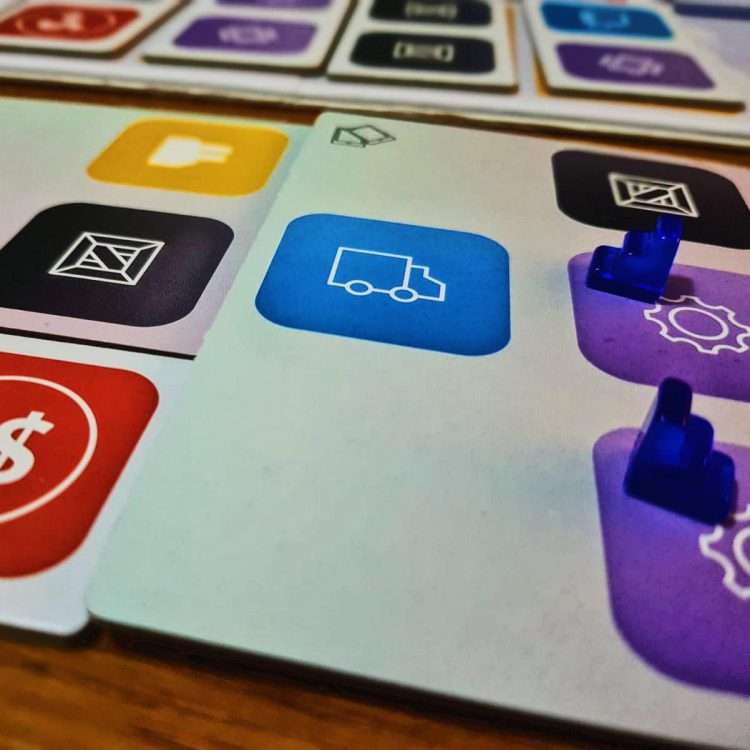
Expansions
The game with 2 expansions in the box. You have heard me mention ‘Steve’ (the A.I.), which allows for solo play, or an additional player up to 5 total. Steve is good and has his own rule book to play with him, along with his own board and token. Additionally, they have included the ‘Update 1.1’ book that throws in a number of additional challenges and technologies for the game, along with a 2-3 player module. And if that’s not enough, they throw in a Hardcore mode that totally messes with Phases 2-6. Let me summarize what hard mode adds. In the main game you take actions and they are free. Now, not so much. Not only do you have to pay to place tokens, but there is also interest charged, and ways to lose Victory Points. This is for those who think they have mastered the game, and need that ‘Dark Souls’ method of play.
Artwork & Component Quality
Cosmodrome Games did the right thing and used Kickstarter to fund the development tweaks and components upgrades of this game, and you can see it shines. High quality graphics, materials, game-board, cards, pieces, screens. They did the game right by going that road. Artwork is clean and easy to distinguish from each other, which is important as the game is icon heavy. And I do mean very icon heavy. That being said, the icons are pretty clear what they represent (money symbol for price, truck for logistics, gears for technology, etc), but it will take a few games to get them all down without having to stop and think what it represents.
The rule-books are solid, and has lots of references to examples to help understand how the different phases work. They have done a great job translating this to English and doing an easy-to-ready layout in all the books and boards.

What works
Let me start with saying that at first, there’s a lot going on in the game.. knowing that the placement of your pads in Phase 1 determine everything that happens the rest of the round is tough, especially when you’re learning the game. Trust me, been there, still sometimes struggle with the ‘what do I need to do this round, and why did they all choose so fast’, especially when starting in different regions. But (you knew there was a but coming), it works. And is solid! After a few rounds, you’ll get it, and start planning on how to take over another region before someone else does, or buy a patent for the quick victory points (I mean, it’s not like you are hate drafting it so someone else can’t have it, right?). Even after knowing how to play, you will always have to think in Phase 1 of each round and plan how everything is going to work out, and that price board impacting the order for the phases just wrecks your plans sometimes.
What doesn’t work
Do not, and I mean it, do not play with a few players that have AP if you do not have patience. You will not enjoy the game, and after 2 hours with 2 rounds still to go, the group will just quit. Do not be that group. You do want to play with a group of folks (or solo) that have your play-style to keep the game moving around. There is some downtime between your turn, but it is not bad at all as you can spend it planning how you want to move the next round. Iconography is heavy in the game, but the game-board does help with it, as does the rule-book.
Final Thoughts
This is one of the most fun games I’ve played where you absolutely have to plan ahead. From the solo game with the A.I to a 5 player game (still with the A.I), the game is smooth… really smooth.. You can tell that this has gone through some serious game-play before they put it out. The buzz came out in 2018 at Essen, and they just tweaked and polished it, finally settling with Cosmodrome Games as the publisher. If you like games like Agricola or Five Tribes, this one will be hitting the table a lot.
